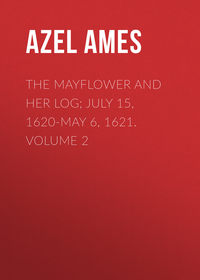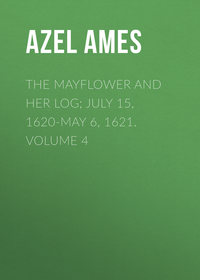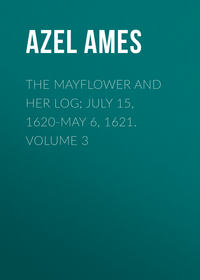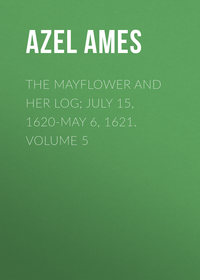 полная версия
полная версияThe Mayflower and Her Log; July 15, 1620-May 6, 1621. Volume 1
The Family of Deacon John Carver (probably in charge of John Howland), embracing:—
Mrs. Katherine Carver,
John Howland (perhaps kinsman of Carver), "servant" or "employee,"
Desire Minter, or Minther (probably companion of Mrs. Carver,
perhaps kinswoman),
Roger Wilder, "servant,"
"Mrs. Carver's maid" (whose name has never transpired).
Master William Bradford and
Mrs. Dorothy (May) Bradford.
Master Edward Winslow and
Mrs. Elizabeth (Barker) Winslow,
George Soule a "servant" (or employee),
Elias Story, "servant."
Elder William Brewster and
Mrs. Mary Brewster,
Love Brewster, a son,
Wrestling Brewster, a son.
Master Isaac Allerton and
Mrs. Mary (Morris) Allerton,
Bartholomew Allerton, a son,
Remember Allerton, a daughter,
Mary Allerton, a daughter,
John Hooke, "servant-boy."
Dr. Samuel Fuller and
William Butten, "servant"-assistant.
Captain Myles Standish and
Mrs. Rose Standish.
Master William White and
Mrs. Susanna (Fuller) White,
Resolved White, a son,
William Holbeck, "servant,"
Edward Thompson, "servant."
Deacon Thomas Blossom and
—– Blossom, a son.
Master Edward Tilley and
Mrs. Ann Tilley.
Master John Tilley and
Mrs. Bridget (Van der Velde?) Tilley (2d wife),
Elizabeth Tilley, a daughter of Mr. Tilley by a former wife(?)
John Crackstone and
John Crackstone (Jr.), a son.
Francis Cooke and
John Cooke, a son.
John Turner and
—– Turner, a son,
–– Turner, a son.
Degory Priest.
Thomas Rogers and
Joseph Rogers, a son.
Moses Fletcher.
Thomas Williams.
Thomas Tinker and
Mrs. – Tinker,
–– Tinker, a son.
Edward Fuller and
Mrs. – Fuller,
Samuel Fuller, a son.
John Rigdale and
Mrs. Alice Rigdale.
Francis Eaton and
Mrs. – Eaton,
Samuel Eaton, an infant son.
Peter Browne.
William Ring.
Richard Clarke.
John Goodman.
Edward Margeson.
Richard Britteridge.
Mrs. Katherine Carver and her family, it is altogether probable, came over in charge of Howland, who was probably a kinsman, both he and Deacon Carver coming from Essex in England,—as they could hardly have been in England with Carver during the time of his exacting work of preparation. He, it is quite certain, was not a passenger on the Speedwell, for Pastor Robinson would hardly have sent him such a letter as that received by him at Southampton, previously mentioned (Bradford's "Historie," Deane's ed. p. 63), if he had been with him at Delfshaven at the "departure," a few days before. Nor if he had handed it to him at Delfshaven, would he have told him in it, "I have written a large letter to the whole company."
John Howland was clearly a "secretary" or "steward," rather than a "servant," and a man of standing and influence from the outset. That he was in Leyden and hence a SPEEDWELL passenger appears altogether probable, but is not absolutely certain.
Desire Minter (or Minther) was undoubtedly the daughter of Sarah, who, the "Troth Book" (or "marriage-in-tention" records) for 1616, at the Stadtbuis of Leyden, shows, was probably wife or widow of one William Minther—evidently of Pastor Robinson's congregation—when she appeared on May 13 as a "voucher" for Elizabeth Claes, who then pledged herself to Heraut Wilson, a pump-maker, John Carver being one of Wilson's "vouchers." In 1618 Sarah Minther (then recorded as the widow of William) reappeared, to plight her troth to Roger Simons, brick-maker, from Amsterdam. These two records and the rarity of the name warrant an inference that Desire Minter (or Minther) was the daughter of William and Sarah (Willet) Minter (or Minther), of Robinson's flock; that her father had died prior to 1618 (perhaps before 1616); that the Carvers were near friends, perhaps kinsfolk; that her father being dead, her mother, a poor widow (there were clearly no rich ones in the Leyden congregation), placed this daughter with the Carvers, and, marrying herself, and removing to Amsterdam the year before the exodus, was glad to leave her daughter in so good a home and such hands as Deacon and Mistress Carver's. The record shows that the father and mother of Mrs. Sarah Minther, Thomas and Alice Willet, the probable grandparents of Desire Minter, appear as "vouchers" for their daughter at her Leyden betrothal. Of them we know nothing further, but it is a reasonable conjecture that they may have returned to England after the remarriage of their daughter and her removal to Amsterdam, and the removal of the Carvers and their granddaughter to America, and that it was to them that Desire went, when, as Bradford records, "she returned to her friends in England, and proved not very well and died there."
"Mrs. Carver's maid" we know but little about, but the presumption is naturally strong that she came from; Leyden with her mistress. Her early marriage and; death are duly recorded.
Roger Wilder, Carver's "servant;" was apparently in his service at Leyden and accompanied the family from thence. Bradford calls him "his [Carver's] man Roger," as if an old, familiar household servant, which (as Wilder died soon after the arrival at Plymouth) Bradford would not have been as likely to do—writing in 1650, thirty years after—if he had been only a short-time English addition to Carver's household, known to Bradford only during the voyage. The fact that he speaks of him as a "man" also indicates something as to his age, and renders it certain that he was not an "indentured" lad. It is fair to presume he was a passenger on the SPEEDWELL to Southampton. (It is probable that Carver's "servant-boy," William Latham, and Jasper More, his "bound-boy," were obtained in England, as more fully appears.)
Master William Bradford and his wife were certainly of the party in the SPEEDWELL, as shown by his own recorded account of the embarkation. (Bradford's "Historie," etc.)
Master Edward Winslow's very full (published) account of the embarkation ("Hypocrisie Unmasked," pp. 10-13, etc.) makes it certain that himself and family were SPEEDWELL passengers.
George Soule, who seems to have been a sort of "upper servant" or "steward," it is not certain was with Winslow in Holland, though it is probable.
Elias Story, his "under-servant," was probably also with him in Holland, though not surely so. Both servants might possibly have been procured from London or at Southampton, but probably sailed from Delfshaven with Winslow in the SPEEDWELL.
Elder William Brewster and his family, his wife and two boys, were passengers on the SPEEDWELL, beyond reasonable doubt. He was, in fact, the ranking man of the Leyden brethren till they reached Southampton and the respective ships' "governors" were chosen. The Church to that point was dominant. (The Elder's two "bound-boys," being from London, do not appear as SPEEDWELL passengers.) There is, on careful study, no warrant to be found for the remarkable statements of Goodwin ("Pilgrim Republic," p. 33), that, during the hunt for Brewster in Holland in 1619, by the emissaries of James I. of England (in the endeavor to apprehend and punish him for printing and publishing certain religious works alleged to be seditious), "William Brewster was in London . . . and there he remained until the sailing of the MAYFLOWER, which he helped to fit out;" and that during that time "he visited Scrooby." That he had no hand whatever in fitting out the MAYFLOWER is certain, and the Scrooby statement equally lacks foundation. Professor Arber, who is certainly a better authority upon the "hidden press" of the Separatists in Holland, and the official correspondence relating to its proprietors and their movements, says ("The Story of the Pilgrim Fathers," p.196): "The Ruling Elder of the Pilgrim Church was, for more than a year before he left Delfshaven on the SPEEDWELL, on the 22 July- 1 August, 1620, a hunted man." Again (p. 334), he says: "Here let us consider the excellent management and strategy of this Exodus. If the Pilgrims had gone to London to embark for America, many, if not most of them, would have been put in prison [and this is the opinion of a British historian, knowing the temper of those times, especially William Brewster.] So only those embarked in London against whom the Bishops could take no action." We can understand, in light, why Carver—a more objectionable person than Cushman to the prelates, because of his office in the Separatist Church—was chiefly employed out of their sight, at Southampton, etc., while the diplomatic and urbane Cushman did effective work at London, under the Bishops' eyes. It is not improbable that the personal friendship of Sir Robert Naunton (Principal Secretary of State to King James) for Sir Edward Sandys and the Leyden brethren (though officially seemingly active under his masters' orders in pushing Sir Dudley Carleton, the English ambassador at the Hague, to an unrelenting search for Brewster) may have been of material aid to the Pilgrims in gaining their departure unmolested. The only basis known for the positive expression of Goodwin resides in the suggestions of several letters' of Sir Dudley Carleton to Sir Robert Naunton, during the quest for Brewster; the later seeming clearly to nullify the earlier.
Under date of July 22, 1619, Carleton says: "One William Brewster, a Brownist, who has been for some years an inhabitant and printer at Leyden, but is now within these three weeks removed from thence and gone back to dwell in London," etc.
On August 16, 1619 (N.S.), he writes: "I am told William Brewster is come again for Leyden," but on the 30th adds: "I have made good enquiry after William Brewster and am well assured he is not returned thither, neither is it likely he will; having removed from thence both his family and goods," etc.
On September 7, 1619 (N.S.), he writes: "Touching Brewster, I am now informed that he is on this side the seas [not in London, as before alleged]; and that he was seen yesterday, at Leyden, but, as yet, is not there settled," etc.
On September 13, 1619 (N.S.), he says: "I have used all diligence to enquire after Brewster; and find he keeps most at Amsterdam; but being 'incerti laris', he is not yet to be lighted upon. I understand he prepares to settle himself at a village called Leerdorp, not far from Leyden, thinking there to be able to print prohibited books without discovery, but I shall lay wait for him, both there and in other places, so as I doubt but either he must leave this country; or I shall, sooner or later, find him out."
On September 20, 1619 (N.S.), he says: "I have at length found out Brewster at Leyden," etc. It was a mistake, and Brewster's partner (Thomas Brewer), one of the Merchant Adventurers, was arrested instead.
On September 28, 1619 (N.S.), he states, writing from Amsterdam: "If he lurk here for fear of apprehension, it will be hard to find him," etc.
As late as February 8, 1619/20, there was still a desire and hope for his arrest, but by June the matter had become to the King—and all others—something of an old story. While, as appears by a letter of Robert Cushman, written in London, in May, 1619, Brewster was then undoubtedly there, one cannot agree, in the light of the official correspondence just quoted, with the conclusion of Dr. Alexander Young ("Chronicles of the Pilgrim Fathers," vol. i. p. 462), that "it is probable he [Brewster] did not return to Leyden, but kept close till the MAYFLOWER sailed."
Everything indicates that he was at Leyden long after this; that he did not again return to London, as supposed; and that he was in hiding with his family (after their escape from the pursuit at Leyden), somewhere among friends in the Low Countries. Although by July, 1620, the King had, as usual, considerably "cooled off," we may be sure that with full knowledge of the harsh treatment meted out to his partner (Brewer) when caught, though unusually mild (by agreement with the authorities of the University and Province of Holland), Brewster did not deliberately put himself "under the lion's paw" at London, or take any chances of arrest there, even in disguise. Dr. Griffis has lent his assent (" The Pilgrims in their Homes," p, 167), though probably without careful analysis of all the facts, to the untenable opinion expressed by Goodwin, that Brewster was "hiding in England" when the SPEEDWELL sailed from Delfshaven. There can be no doubt that, with his ever ready welcome of sound amendment, he will, on examination, revise his opinion, as would the clear-sighted Goodwin, if living and cognizant of the facts as marshalled against his evident error. As the leader and guide of the outgoing part of the Leyden church we may, with good warrant, believe—as all would wish—that Elder Brewster was the chief figure the departing Pilgrims gathered on the SPEEDWELL deck, as she took her departure from Delfshaven.
Master Isaac Allerton and his family, his wife and three children, two sons and a daughter, were of the Leyden company and passengers in the SPEEDWELL. We know he was active there as a leader, and was undoubtedly one of those who bought the SPEEDWELL. He was one of the signers of the joint-letter from Leyden, to Carver and Cushman, May 31 (O.S.) 1620.
John Hooke, Allerton's "servant-lad," may have been detained at London or Southampton, but it is hardly probable, as Allerton was a man of means, consulted his comfort, and would have hardly started so large a family on such a journey without a servant.
Dr. Samuel Fuller was, as is well known, one of the Leyden chiefs, connected by blood and marriage with many of the leading families of Robinson's congregation. He was active in the preparations for the voyage the first signer of the joint-letter of May 31, and doubtless one of the negotiators for the SPEEDWELL. His wife and child were left behind, to follow later as they did.
William Butten, the first of the Pilgrim party to die, was, in all probability, a student-"servant" of Doctor Fuller at Leyden, and doubtless embarked with him at Delfshaven. Bradford calls him (writing of his death) "Wm. Butten, a youth, servant to Samuel Fuller." Captain Myles Standish and his wife Rose, we know from Bradford, were with the Pilgrims in Leyden and doubtless shipped with them. Arber calls him ("The Story of the Pilgrim Fathers," p. 378) a "chief of the Pilgrim Fathers" in the sense of a father and leader in their Israel; but there is no warrant for this assumption, though he became their "sword-hand" in the New World. By some writers, though apparently with insufficient warrant, Standish has been declared a Roman Catholic. It does not appear that he was ever a communicant of the Pilgrim Church. His family, moreover, was not of the Roman Catholic faith, and all his conduct in the colony is inconsistent with the idea that he was of that belief. Master William White, his wife and son, were of the Leyden congregation, both husband and wife being among its principal people, and nearly related to several of the Pilgrim band. The marriage of Mr. and Mrs. White is duly recorded in Leyden. William Holbeck and Edward Thompson, Master White's two servants, he probably took with him from Leyden, as his was a family of means and position, though they might possibly have been procured at Southampton. They were apparently passengers in the SPEEDWELL. Deacon Thomas Blossom and his son were well known as of Pastor Robinson's flock at Leyden. They returned, moreover, to Holland from Plymouth, England (where they gave up the voyage), via London. The father went to New Plymouth ten years later, the son dying before that time. (See Blossom's letter to Governor Bradford. Bradford's Letter Book, "Plymouth Church Records," i. 42.) In his letter dated at Leyden, December 15, 1625, he says: "God hath taken away my son that was with me in the ship MAYFLOWER when I went back again."
Edward Tilley (sometimes given the prefix of Master) his wife Ann are known to have been of the Leyden company. (Bradford's "Historie," p. 83.) It is doubtful if their "cousins," Henry Sampson and Humility Cooper, were of Leyden. They apparently were English kinsfolk, taken to New England with the Tilleys, very likely joined them at Southampton and hence were not of the SPEEDWELL'S passengers. Humility Cooper returned to England after the death of Tilley and his wife. That Mrs. Tilley's "given name" was Ann is not positively established, but rests on Bradford's evidence.
John Tilley (who is also sometimes called Master) is reputed a brother of Edward, and is known to have been—as also his wife—of the Leyden church (Bradford, Deane's ed. p. 83.) His second wife Bridget Van der Velde, was evidently of Holland blood, and their marriage is recorded in Leyden. Elizabeth Tilley was clearly a daughter by an earlier wife. He is said by Goodwin ("Pilgrim Republic," p. 32) to have been a "silk worker" Leyden, but earlier authority for this occupation is not found.
John Crackstone is of record as of the Leyden congregation. His daughter remained there, and came later to America.
John Crackstone, Jr., son of above. Both were SPEEDWELL passengers.
Francis Cooke has been supposed a very early member of Robinson's flock in England, who escaped with them to Holland, in 1608. He and his son perhaps embarked at Delfshaven, leaving his wife and three other children to follow later. (See Robinson's letter to Governor Bradford, "Mass. Hist. Coll.," vol. iii. p. 45, also Appendix for account of Cooke's marriage.)
John Cooke, the son, was supposed to have lived to be the last male survivor of the MAY-FLOWER, but Richard More proves to have survived him. He was a prominent man in the colony, like his father, and the founder of Dartmouth (Mass.).
John Turner and his sons are also known to have been of the Leyden party, as he was undoubtedly the messenger sent to London with the letter (of May 31) of the leaders to Carver and Cushman, arriving there June 10, 1620. They were beyond doubt of the SPEEDWELL'S list.
Degory Priest—or "Digerie," as Bradford calls him—was a prominent member of the Leyden body. His marriage is recorded there, and he left his family in the care of his pastor and friends, to follow him later. He died early.
Thomas Rogers and his son are reputed of the Leyden company. He left (according to Bradford) some of his family there—as did Cooke and Priest—to follow later. It has been suggested that Rogers might have been of the Essex (England) lineage, but no evidence of this appears. The Rogers family of Essex were distinctively Puritans, both in England and in the Massachusetts colony.
Moses Fletcher was a "smith" at Leyden, and of Robinson's church. He was married there, in 1613, to his second wife. He was perhaps of the English Amsterdam family of Separatists, of that name. As the only blacksmith of the colonists, his early death was a great loss.
Thomas Williams, there seems no good reason to doubt, was the Thomas Williams known to have been of Leyden congregation. Hon. H. C. Murphy and Arber include him—apparently through oversight alone— in the list of those of Leyden who did not go, unless there were two of the name, one of whom remained in Holland.
Thomas Tinker, wife, and son are not certainly known to have been of the Leyden company, or to have embarked at Delfshaven, but their constant association in close relation with others who were and who so embarked warrants the inference that they were of the SPEEDWELL'S passengers. It is, however, remotely possible, that they were of the English contingent.
Edward Fuller and his wife and little son were of the Leyden company, and on the SPEEDWELL. He is reputed to have been a brother of Dr. Fuller, and is occasionally so claimed by early writers, but by what warrant is not clear. John Rigdale and his wife have always been placed by tradition and association with the Leyden emigrants but there is a possibility that they were of the English party. Probability assigns them to the SPEEDWELL, and they are needed to make her accredited number.
Francis Eaton, wife, and babe were doubtless of the Leyden list. He is said to have been a carpenter there (Goodwin, "Pilgrim Republic," p. 32), and was married there, as the record attests.
Peter Browne has always been classed with the Leyden party. There is no established authority for this except tradition, and he might possibly have been of the English emigrants, though probably a SPEEDWELL passenger; he is needed to make good her putative number.
William Ring is in the same category as are Eaton and Browne. Cushman speaks of him, in his Dartmouth letter to Edward Southworth (of August 17), in terms of intimacy, though this, while suggestive, of course proves nothing, and he gave up the voyage and returned from Plymouth to London with Cushman. He was certainly from Leyden.
Richard Clarke is on the doubtful list, as are also John Goodman, Edward Margeson, and Richard Britteridge. They have always been traditionally classed with the Leyden colonists, yet some of them were possibly among the English emigrants. They are all needed, however, to make up the number usually assigned to Leyden, as are all the above "doubtfuls," which is of itself somewhat confirmatory of the substantial correctness of the list.
Thomas English, Bradford records, "was hired to goe master of a [the] shallopp" of the colonists, in New England waters. He was probably hired in Holland and was almost certainly of the SPEEDWELL.
John Alderton (sometimes written Allerton) was, Bradford states, "a hired man, reputed [reckoned] one of the company, but was to go back (being a seaman) [and so making no account of the voyages for the help of others behind" [probably at Leyden]. It is probable that he was hired in Holland, and came to Southampton on the SPEEDWELL. Both English and Alderton seem to have stood on a different footing from Trevore and Ely, the other two seamen in the employ of the colonists.
William Trevore was, we are told by Bradford, "a seaman hired to stay a year in the countrie," but whether or not as part of the SPEEDWELL'S Crew (who, he tells us, were all hired for a year) does not appear. As the Master (Reynolds) and others of her crew undoubtedly returned to London in her from Plymouth, and her voyage was cancelled, the presumption is that Trevore and Ely were either hired anew or—more probably—retained under their former agreement, to proceed by the MAY-FLOWER to America, apparently (practically) as passengers. Whether of the consort's crew or not, there can be little doubt that he left Delfshaven on the SPEEDWELL.
–– Ely, the other seaman in the Planters' employ, also hired to "remain a year in the countrie," appears to have been drafted, like Trevore, from the SPEEDWELL before she returned to London, having, no doubt, made passage from Holland in her. Both Trevore and Ely survived "the general sickness" at New Plimoth, and at the expiration of the time for which they were employed returned on the FORTUNE to England
Of course the initial embarkation, on Friday, July 21/31 1620, was at Leyden, doubtless upon the Dutch canal-boats which undoubtedly brought them from a point closely adjacent to Pastor Robinson's house in the Klock-Steeg (Bell, Belfry, Alley), in the garden of which were the houses of many, to Delfshaven.
Rev. John Brown, D.D., says: "The barges needed for the journey were most likely moored near the Nuns' Bridge which spans the Rapenburg immediately opposite the Klok-Steeg, where Robinsons house was. This, being their usual meeting-place, would naturally be the place of rendezvous on the morning of departure. From thence it was but a stone's throw to the boats, and quickly after starting they would enter the Vliet, as the section of the canal between Leyden and Delft is named, and which for a little distance runs within the city bounds, its quays forming the streets. In those days the point where the canal leaves the city was guarded by a water-gate, which has long since been removed, as have also the town walls, the only remaining portions of which are the Morsch-gate and the Zylgate. So, gliding along the quiet waters of the Vliet, past the Water-gate, and looking up at the frowning turrets of the Cow-gate, 'they left that goodly and pleasant city which had been their resting-place near twelve years.' . . . Nine miles from Leyden a branch canal connects the Vliet with the Hague, and immediately beyond their junction a sharp turn is made to the left, as the canal passes beneath the Hoom-bridge; from this point, for the remaining five miles, the high road from the Hague to Delft, lined with noble trees, runs side by side with the canal. In our time the canal-boats make a circuit of the town to the right, but in those days the traffic went by canal through the heart of the city . . . . Passing out of the gates of Delft and leaving the town behind, they had still a good ten miles of canal journey before them ere they reached their vessel and came to the final parting, for, as Mr. Van Pelt has clearly shown, it is a mistake to confound Delft with Delfshaven, as the point of embarkation in the SPEEDWELL. Below Delft the canal, which from Leyden thither is the Vliet, then becomes the Schie, and at the village of Overschie the travellers entered the Delfshaven Canal, which between perfectly straight dykes flows at a considerable height above the surrounding pastures. Then finally passing through one set of sluice gates after another, the Pilgrims were lifted from the canal into a broad receptacle for vessels, then into the outer haven, and so to the side of the SPEEDWELL as she lay at the quay awaiting their arrival."








